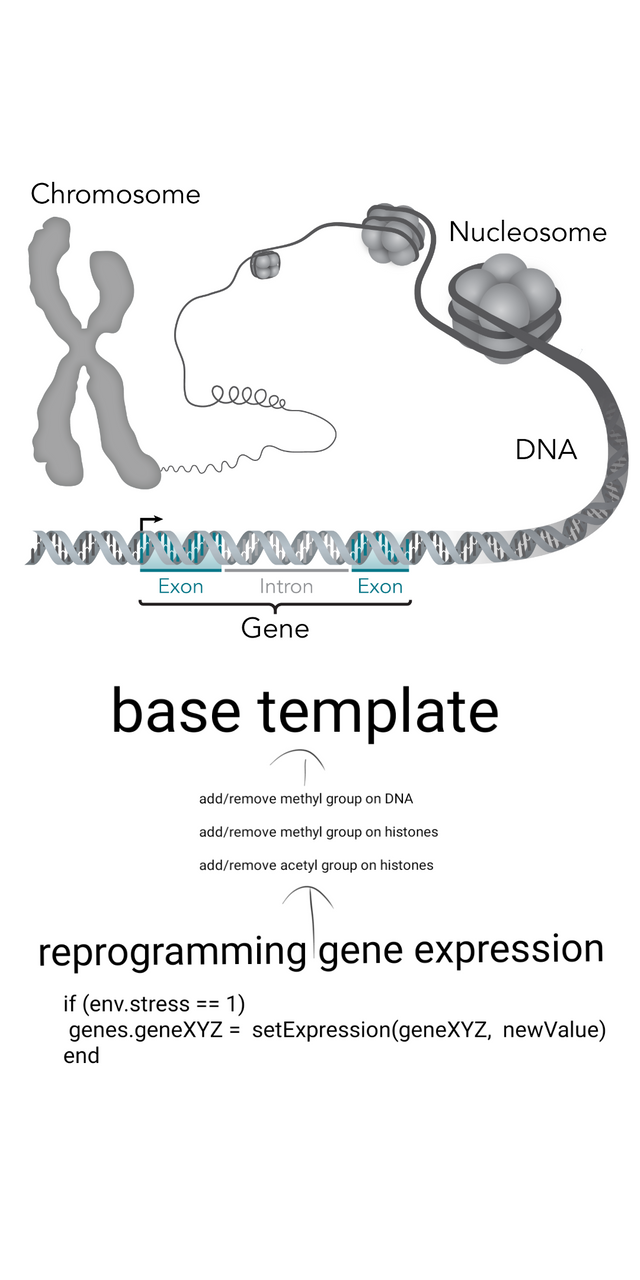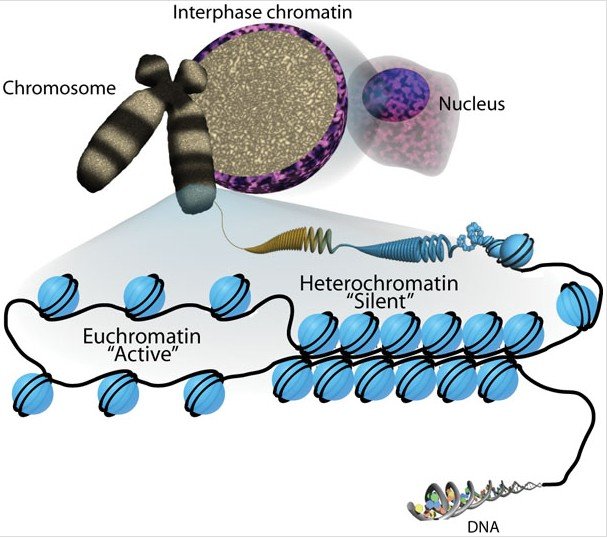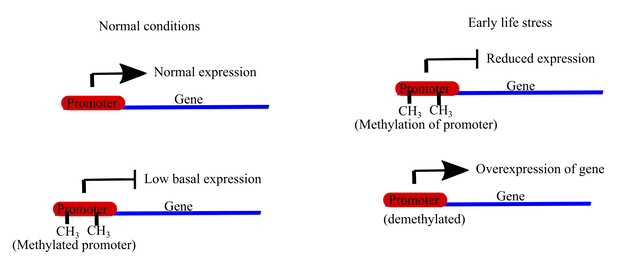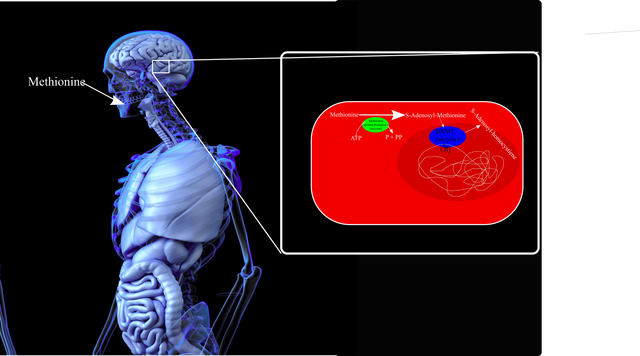Strategies for reversing the programming of environment on our genes (Part 1 - non-invasive brute force)
It was never a question of nature vs nurture. It always boils down to nature and nurture. And we are just beginning to unfold the mechanisms by which nurture reprograms the nature to behave in a certain way. Given that this reprogramming can be crucial for our health, the question arises if we can reverse the ill effects of nurture that we may encounter, ever?

Adapted from image by CNX OpenStax | CC BY 4.0
Understanding the syntax for programming genes
Box 1: Histone modification

Image by Sha, K. and Boyer, L. A. The chromatin signature of pluripotent cells (May 31, 2009), StemBook, ed. The Stem Cell Research Community, StemBook | CC by 3.0
The DNA inside your cells is not just a thread floating freely. I mean, you don't want it to get entangled like your headphones. Hence, it is a good idea to fold it in a certain way and keep it, just like you nicely keep your headphones or any other wires. The task is achieved by these proteins called histones. Like you can see in the image that DNA is wrapped around these protein complexes. Now this wrapping around can be lose (euchromatin) or tight (heterochromatin). When it is tightly wound the genes are unavailable for expression. However, histones can be chemically modified. By chemically modifying the surface of histones - like by adding methyl and acetyl groups, the cell can hence control availability of genes and their expression.
Box 2: DNA methylation

Illustrated by @scienceblocks
Also used in my previous blog
At specific sites in gene promoters, an enzyme called DNA methyl transferase can add a methyl group to DNA base - cytosine. This hinders the binding of proteins to DNA that are required for its expression. Moreover, there is another group of proteins called MBDs which binds to methylated DNA and doesn't let other proteins bind to it. Anyway, you see, two things can happen here. If methyl group is added to promoter of the gene, it reduces its expression. On the other hand environment can also lead to an increase in the expression of the gene by removing the methylation from the promoter, that is supposed to be methylated otherwise.
If you think of your genetic code as computer program, then your genes are functions in that code. However, which function are accessible and how much of it can be called is decided dynamically - the regulation of gene expression. Turns out, the regulation is dynamically programmed by environment. Yeah, much like your machine learning neural networks increasing and decreasing their weights. However, instead of weights being an abstract idea here, they are physically regulated by chemical changes. The two main chemical changes that occur are methylation of promoters of the genes and modification of histones, proteins on which the DNA is wrapped around. These changes determine the biding affinity of these proteins called transcription factors to the gene promoters or its availability to bind to these proteins. Since transcription factors control the binding of RNA polymerase to the gene, it therefore controls the rate at which any gene is expressed. Overall, this is called the epigenetic regulation of gene expression.
In the many of my previous posts, I hinted, how the environment throughout our lives reprograms our gene expression. For instance, in earlier blogs I highlighted the importance of epigenetic reprogramming that happens during fetal life and childhood. Moreover, I also wrote about these epigenetic reprogramming being heritable. In a nutshell, we saw how stressful environment reprograms our gene expression and becomes a risk factor for many mental and physical diseases; and not just for us but for generations to come. This made many people who read these articles ask me the following question - is there a way to reverse this reprogramming? Which motivated me to write this post, where I will be discussing the possible strategies in this regard.
Breaking the loops
Epigenetic changes are not limited to childhood. They happen all along the course of our life. However, what makes early life changes in womb and childhood so important is that they start cascade of events. And trying to reverse that cascade would be very difficult, though not impossible. Now, I don't know about perfect reversal , but if the negative psychological environment results in certain changes modification, a positive reinforcement might come handy.
Environment enrichment benefits via epigenetic reprogramming
For instance, we saw that prenatal and early life stress lead to epigenetic changes that affect brain development, metabolism, immune response and stress response in a negative way. On the other hand, environmental enrichment seems to have a positive effect. Like, pet animals seem to perform better in memory tasks than lab animals (McCreary and Metz, 2016). The overall health outcomes, of an enriched environment seem to be positive. Moreover, we saw in the earlier post that a gene called BDNF which important for brain development and memory is downregulated in animals and humans who have faced early life stress. On the contrary, intervention by enriching the environment early in life, leads to upregulation of this gene via modification of histones (Branchi et al., 2011). Then, in 2016, Griñan-Ferré et al., showed that environment enrichment yield positive affects even in a genetic model doomed to accelerated aging. They showed that enriching environment reprogrammed the gene expression in mouse such that - it had increased expression of genes protecting against neurological damage, oxidative stress (remember that mitochondria and ROS and mitochondria from previous blog), and decreased expression of inflammation causing genes - such as IL6.

**Can environmental enrichment reverse the bad epigenetic programming? **
Image by Jacquelinekato | CC BY-SA 3.0
Intervention via stress-free and exciting environment
In this regard, McCreary and Metz, 2016, reviewed multiple studies that tested the possibility of reversal of prenatal stress by environmental enrichment of offspring. Their table 1, summarizes the animal studies showing affect of prenatal stress on animal behaviour and cognition, along with what gets reversed by environment enrichment. Now, maybe everytime, everything does not get reversed, it kind of depends on the stressor type and duration etc plus the kind of intervention used. Nonetheless, overall picture from this summary looks promising. Then in table 2, you can see the genes that go up or down during prenatal stress and in prenatal stress countered with environment enrichment. I would like to point specifically to molecular markers regarding immune system. In the stress-immune system field, there is a dichotomy - that how stress on one hand leads to decrease in adaptive immunity while increase in innate immune response. As you will notice in this table the CD4 and CD8, which are markers of helper and cytotoxic T cells respectively, goes down in stressful conditions. On the other hand, inflammatory cytokines IL-1b, known to recruit and activate neutrophils and macrophages goes up. Interestingly, you will also notice that environment enrichment reverses it.
So what is the fuss about environment enrichment and how does it work out for humans? I mean, what can humans do to cope with stressors they were exposed to as an embryo or as a child? Well this includes things like - physical exercise, listening and learning music, taking a vacation, meditation and many recreational activities. Now, I don't like the controls used in many of the meditation studies (more on that later), but there is some preliminary data supporting that the stress reliving effects of meditation like other enriched environment can reprogram your gene expression for good. For instance, this study done by Kaliman et al., in 2018, shows that histone deacetylases (the enzymes that modifies epigenome) are upregulated by meditation. Moreover, the genes for inflammatory cytokines are downregulated.
Now, I am not saying that meditation will work for you, or it will be music, that is going to reverse ill effects of your childhood. It will depend. It will depend on the person, his/her stressors, I mean everyone will a different favorite poison. A professional will be able to guide you better here. Which method is more efficient for whom, dwells into relam of psychology and psychiatry. I would like to hear @abigail-dantes and @insight-out comments on this.
Running in circles, chasing our tails
Now, we have to realise the fact adults dealing with the after effects of childhood maltreatment are not just going to snap out of it. If you think about it all the ill affects of early life stressors are bound in a feedback loop. For instance, stress promotes anxiety. Anxiety makes you more prone to getting stressed easily. The inflammation induced by stressors promotes obesity and insulin resistance. Obesity and insulin resistance on the other hand promotes depression and anxiety. Mental health in turn along with inflammation can affect eating habits, which can further the progression of obesity and diabetes. Then, no one in depression or obesity gets motivated to exercise. Rather lethargy that accompanies might even demotivate one to give a damn about helping themselves, say by learning music or something. Hence, this loop needs to be broken. Now maybe talking to someone may help. But in many cases it won't. This is where other kinds of interventions become important. So what else can we do to come up with a more efficient paradigm?
Diet and drugs

Adapted from an image by Slon_dots_pics | CC0
Diet can program gene expression
One of commonly cited example of epigenetic changes in adult is that of Dutch hunger winter. The story goes that during dutch famine of 1944-45, the women who were pregnant, gave birth to babies who were more likely to suffer from obesity. The starvation of mother, epigentically reprogrammed the gene expression of babies. Well, probably because body assumed that there is no food in the world and the right thing to do is store whenever you get it. These epigenetic changes can be observed even 6 decades later (see my previous blog).
So, if starvation stress can change the epigenetics of fetus, is there a way we can substitute our diet, to reprogram our genes to our whims? Well not exactly to our whims, but we can make our genome a bit more or bit less methylated based on our diet. The DNA methyl transferases (proteins that metylate the DNA requires a methyl group. The DNMT takes methyl group to attach on DNA from S-Adenosyl-methionine, derived from amino acid - methionine, we have in our diet. Moreover, vitamin B2, B6, B12 are required to convert methionine to S-adenosyl-methionine. Ignore all the fancy chemical names, the take home message is that the cargo for DNA methylation is present in diet. However, does intake of nutrients alter the epigenetic status of cells in the body?
Can diet reverse the detrimental effects of early life stress?
Well, from experiments done in animals and humans it does appear that lack of these nutrients in diet reduces overall methylation state of genome, while adding them to diet increases it (Zhang, 2015). However, a rather interesting question popping in my head is - can I give dietary supplements to reverse the effects of early life stress? According to experiments done by Weaver et al., in 2005, it can. In the last article, I mentioned that stress response can be reprogrammed by epigenetics. Supplementing the diet of the adult animals with methionine amino acid seem to reverse such epigenetic modifications to an extent.
So, if in future if you see such dietary supplements being sold as means to reduce ill effects of early life stress, don't be surprised. In fact even the focus of therupatic treatment of depression and anxiety is being shifted to targeting DNA merhylation and histone acetylation via drugs. The enquiry into how classical antidepressants such as fluoxitine (Prozac) affects epigenetics have already began (Wang et al., 2011). However, I have my doubts regarding how effective these drugs and diets would be. Why?
Well, for starters they are all brute force methods. It's not like all genes are metylated by stress. For instance while gene for BDNF was seen to be downregulated in brain, the gene for FKBP5 was demethylated and upregulated. So what will you be targeting by diet or drugs? Will you supplement food with methionine or remove it? Or will you give a DNMT agonist or antagonist. Will you prefer increasing histone acetylation or will you prefer reducing it? It would be challenging to use the brute force method overall.
Which gets us to specifically targeting the epigenetic modification on a certain gene. Well, because neither diet, nor environmental enrichment seem to provide a perfect tool for targeting specific genes. We are just starting to build and use these technologies. I initially decided to talk about the specific targeting strategy in this post. However, I know you might already have started getting a bit distracted. So I will stop it right here and continue with futuristic technology for epigenome editing in the next part.
About steemstem
But before I go I would like to mention about the steemstem platform. Well, if you love reading and writing interesting science articles @steemstem is the community on steem that support authors and content creators in STEM field. If you wish to support steemstem do see the links below.
You can vote for steemstem witness here -
Quick link for voting for the SteemSTEM Witness(@stem.witness)
Delegation links for @steemstem
(quick delegation links: 50SP | 100SP | 500SP | 1000SP | 5000SP | 10000SP).
Delegating to @steemstem gives ROI of 65% of the curation rewards.
References
Signing off
@scienceblocks
This post has been voted on by the SteemSTEM curation team and voting trail in collaboration with @utopian-io and @curie.
If you appreciate the work we are doing then consider voting all three projects for witness by selecting stem.witness, utopian-io and curie!
For additional information please join us on the SteemSTEM discord and to get to know the rest of the community!
Congratulations,
you just received a 12.84% upvote from @steemhq - Community Bot!
Wanna join and receive free upvotes yourself?

Vote for
steemhq.witnesson Steemit or directly on SteemConnect and join the Community Witness.This service was brought to you by SteemHQ.com
Hi @scienceblocks!
Your post was upvoted by Utopian.io in cooperation with @steemstem - supporting knowledge, innovation and technological advancement on the Steem Blockchain.
Contribute to Open Source with utopian.io
Learn how to contribute on our website and join the new open source economy.
Want to chat? Join the Utopian Community on Discord https://discord.gg/h52nFrV
Hi @scienceblocks!
Your post was upvoted by @steem-ua, new Steem dApp, using UserAuthority for algorithmic post curation!
Your UA account score is currently 3.397 which ranks you at #7008 across all Steem accounts.
Your rank has dropped 35 places in the last three days (old rank 6973).
In our last Algorithmic Curation Round, consisting of 252 contributions, your post is ranked at #73.
Evaluation of your UA score:
Feel free to join our @steem-ua Discord server